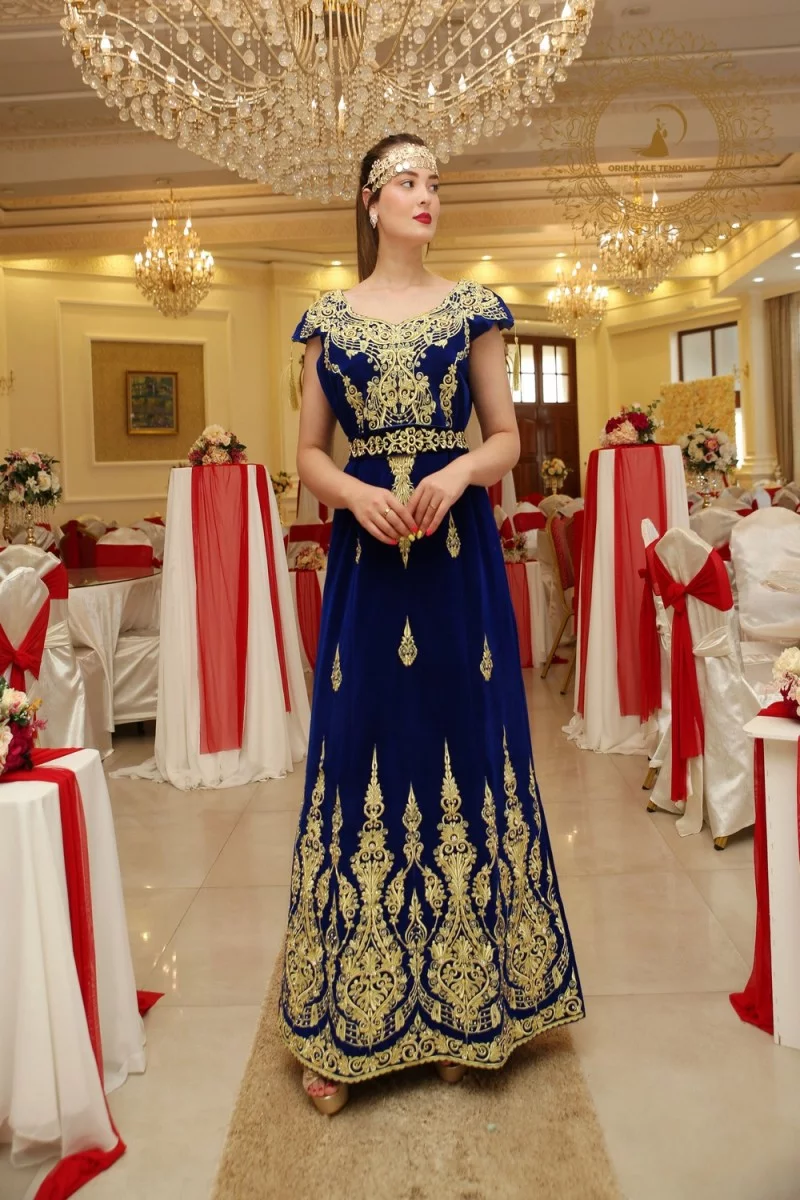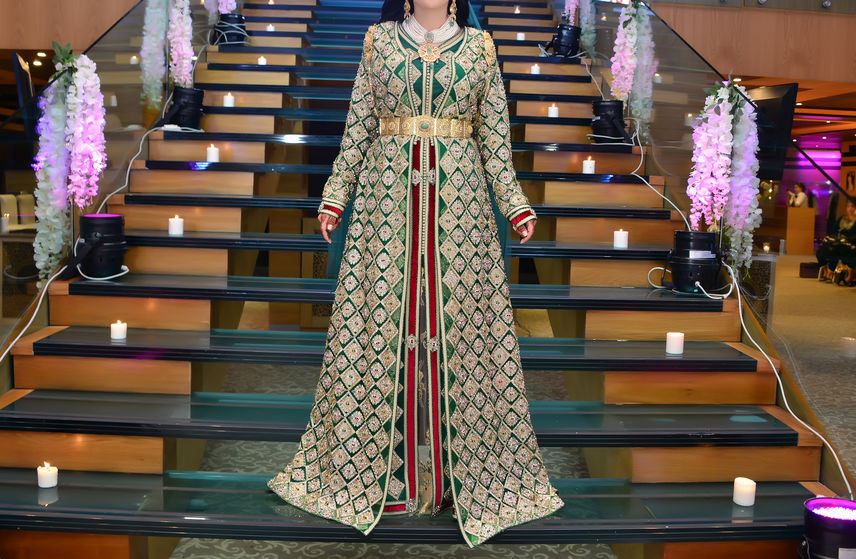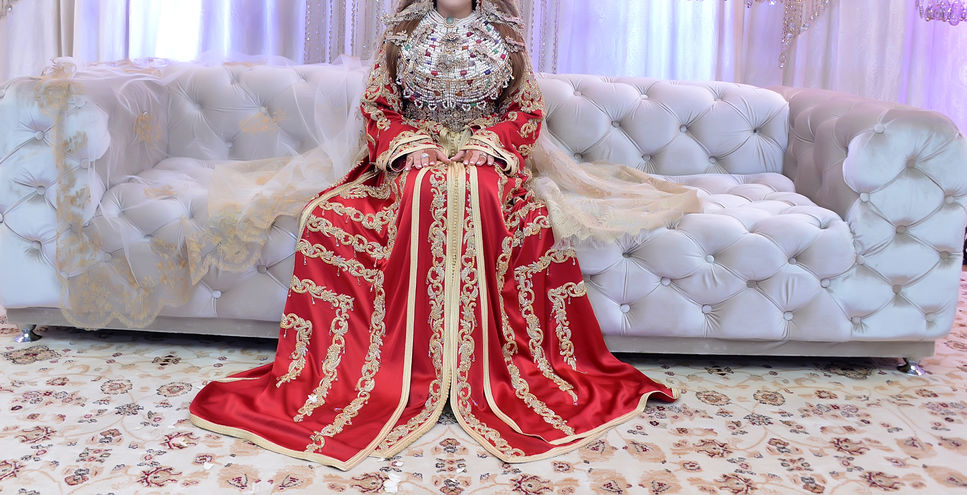The beauty of Algerian dresses

What traditional Algerian dresses are a must-have?
The traditional Algerian wardrobe is rich and diverse. It offers an exceptional panorama of colours, fabrics and embroidery reflecting the country's unique cultural heritage. Given this abundance, choosing the essential pieces can be a real challenge. Let's discover these treasures of Algerian fashion, which combine history, elegance and identity.
The Algerian caftan, the sparkle of Algiers

In the capital, the Algerian caftan stands out for its elegance and refinement. Made from velvet, it sparkles with gold thread embroidery. Algerian women proudly wear it at wedding ceremonies, where it occupies a place of choice. Accessories play a key role in this outfit: antique necklaces and cultured pearls add a touch of authenticity and nobility. The graffache and meskia, traditional ornaments, complete this dress, a symbol of elegance and prestige.
The caftan is passed down from mother to daughter, demonstrating the strong bond between generations. This family heritage is carefully preserved, and each dress tells a unique story. The craftsmen, guardians of this art, perpetuate the tradition by taking particular care with the quality of the fabric and the finesse of the embroidery. Making an Algerian caftan requires patience and meticulousness, reflecting the soul and history of the city of Algiers.
Beyond its traditional aspect, the Algerian caftan also adapts to modern trends. Designers play with colours, textures and patterns to create unique pieces that combine tradition and modernity. This ability to evolve while retaining its essence makes the Algerian caftan a timeless garment, a symbol of Algerian identity.
The Tlemcen Chedda, a cultural jewel

Tlemcen, a city of history and culture, is the birthplace of the Chedda, a traditional dress that captivates with its splendour. Made from satin, it is adorned with a top richly embroidered with gold thread and cultured pearls. This dress is a masterpiece, requiring hours of work and exceptional expertise. It embodies the perfect marriage of elegance and tradition, making it a must-have for special occasions.
The Chedda is much more than just an outfit; it's a work of art in its own right. Every detail, every pearl and every gold thread tells a story, the story of a deeply-rooted cultural heritage. The women of Tlemcen wear this dress with pride and dignity, conveying the values and history of their city.
The importance of the Chedda to Tlemcen's heritage goes beyond its aesthetic appeal. It also plays a crucial role in preserving traditional craft techniques. The craftsmen dedicated to making this garment use age-old techniques, ensuring that it is passed on to future generations.
The indispensable Karakou, the pride of Algiers

The Karakou is another emblematic Algiers garment with a unique style. Combining velvet and silver thread embroidery, this traditional jacket is often worn with seroual trousers. Algerian women wear it for a variety of occasions, from weddings to important celebrations. Karakou stands out for its ability to combine tradition and modernity, appealing to all generations.
The craftsmen, with their exceptional mastery, play a crucial role in preserving this tradition. They are constantly innovating, incorporating modern techniques while respecting traditional manufacturing methods. This approach ensures that the Karakou remains a strong symbol of Algerian cultural identity.
Wearing a Karakou is an affirmation of belonging to a rich and diverse culture. It reflects not only the beauty and elegance of Algerian women, but also their pride and attachment to their roots. Through its patterns and colours, the Karakou tells the story of Algiers, a city of contrasts and diversity.
The Jebba of Annaba, the radiance of the Algerian Levant

The Jebba, a traditional garment emblematic of eastern Algeria, and Annaba in particular, offers a splendid vision of the country's sartorial heritage. Recognisable by its garnet-red colour, it symbolises passion and elegance. Made from velvet, a warm and noble material, the Jebba is adorned with gold-thread embroidery in delicate patterns, reflecting the exceptional skills of local craftsmen. This long dress, a true masterpiece of craftsmanship, embodies pride and prestige at wedding ceremonies, where it is traditionally worn by brides.
The Jebba is not just an outfit, it is a link between the bride and the history and traditions of Annaba. The meticulously applied gold-thread embroidery tells stories of antiquity, evoking times when art and culture flourished. The selection of garnet-red velvet for the Jebba is no accident; it reflects the importance of colour in Algerian culture, where it is often associated with joy, fertility and happiness.
Making a Jebba is a process that requires not only technical precision, but also a deep understanding of cultural traditions. The craftsmen, the true guardians of these traditions, passionately perpetuate the art of embroidery, ensuring that each Jebba is unique. By wearing this dress, Annaba brides are not only celebrating their union; they are paying tribute to a rich and living cultural heritage.
The Constantine Gandoura, a journey through time
Originating in Constantine, the Gandoura is a long dress, a symbol of grace and sophistication. The choice of velvet as the main fabric underlines the nobility of this piece, while the gold thread embroidery enhances its beauty, offering a striking contrast that captures the eye. Worn by women for special occasions, this outfit is a true tribute to femininity and understated elegance.
The designs embroidered on the Gandoura are not chosen at random; they are the result of inspiration drawn from the history and architecture of Constantine. The motifs evoke the fine details of the arches and mosaics that adorn the city's ancient buildings, creating a bridge between Constantine's glorious past and the present. Gold thread embroidery on velvet is a demanding technique, requiring hours of painstaking work and great skill, making each Gandoura a unique piece.
The Gandoura is appreciated not only for its refined aesthetic, but also for its comfort. The soft-touch velvet and loose fit of the dress ensure ease of movement throughout the day or evening. This combination of comfort and elegance makes the Gandoura a great choice for women who want to celebrate their cultural heritage while making a fashion statement.
The Chemsa, a symbol of freshness and authenticity
The Chemsa, with its elegant allure and lightness, is a long cotton dress that embodies refined simplicity. It is distinguished by its delicate embroidery in silk thread, which adds a touch of sophistication and meticulous craftsmanship to the outfit. Often embellished with pearls, the Chemsa reflects a traditional know-how and attention to detail that honours local craftsmanship. This dress is prized for its ability to combine comfort and aesthetics, making it an ideal choice for hot days, when it offers an unrivalled feeling of coolness and lightness.
Worn for a variety of occasions, the Chemsa is a symbol of authenticity and connection with tradition. Its silk thread embroidery, created with exceptional precision and finesse, tells stories of cultures and eras long past. Each embroidered motif, each added bead, is a celebration of cultural heritage, making the Chemsa more than just a dress, but a living narrative of Algerian identity.
Making the Chemsa requires particular expertise, passed down from generation to generation among the craftsmen. The choice of cotton as the main material underlines a preference for natural fabrics, appreciated for their softness and ability to breathe. This characteristic makes Chemsa particularly suited to Algeria's Mediterranean climate, offering an elegant solution to the challenges posed by high temperatures.
The Melhfa, a fabric of tradition and elegance
The Melhfa, a traditional garment worn mainly in the Algerian Sahara, is a remarkable expression of feminine identity and elegance. The garment is a long cloth that wraps around the body, offering both protection from the elements and unparalleled beauty thanks to its bright colours and intricate patterns. It embodies the ability of Saharan cultures to combine functionality and aesthetics, demonstrating a harmonious adaptation to an environment that is both magnificent and demanding.
The richness of Melhfa lies in its diversity of fabrics and designs, with each piece telling a unique story, reflecting traditions, occasions and social status. Saharan women carefully choose the colours and patterns of their Melhfa, reflecting their personality and state of mind. This careful selection makes each Melhfa a personal symbol of pride and belonging.
The art of wearing the Melhfa is passed down from mother to daughter, an initiation ritual that strengthens community ties and perpetuates ancestral knowledge. This transmission is crucial to the preservation of cultural identity, making the Melhfa much more than just a garment: it becomes a living heritage, a textile archive of collective memory.
By embracing the Melhfa, Saharan communities are celebrating not only their heritage, but also their resilience in the face of the region's climatic challenges. This garment is a testament to human creativity and ingenuity, capable of creating beauty and meaning in the most arid conditions. Worn at celebrations, weddings and in everyday life, the Melhfa is an emblem of unity and cultural continuity, an Ariadne's thread linking the past to the present and opening up prospects for the future.
Kabyle dress, a mirror of Berber identity
The Kabyle dress, emblematic of the Kabylie region of Algeria, is an ornament that reflects the very essence of Berber identity. Characterised by its bright colours and symbolic motifs, the dress is more than just a garment; it is a living testimony to the cultural richness and history of a people. Traditionally made from cotton, it is distinguished by its bold use of geometric patterns and embroidery, which are not just decorative, but carry profound meanings linked to nature, fertility and protection.
At the heart of Kabyle society, the dress is a central element in major ceremonies and traditional celebrations, particularly weddings. Every element of the dress, from the colours to the embroidery, is carefully chosen to represent the personality and history of the wearer. The craftsmen, the true guardians of this heritage, perpetuate the ancestral techniques of weaving and embroidery with passion and precision, ensuring that this art is passed down from generation to generation.
Modernity has in no way eroded the Kabyle people's attachment to this traditional dress. On the contrary, Kabyle dress has evolved over time, incorporating contemporary touches without ever losing sight of the essence of its heritage. Today, it symbolises the pride of an enduring Berber identity. A bridge between past and present, celebrating a culture rich in colour, history and values.
